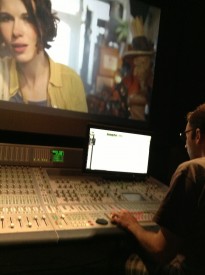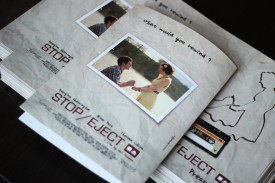Back in November 2012 I posted and analysed the preproduction and production budget for my short film Stop/Eject, a 17 minute fantasy-drama which was shot on a DSLR. Now I’m going to do the same for the postproduction budget, including distribution and marketing. We’re currently selling Blu-rays and digital rentals of Stop/Eject, to raise money for further film festival entries, so please support us by buying a copy if you find this blog useful.
 Download the budget here as a PDF (35kb).
Download the budget here as a PDF (35kb).
As you can see, we had almost £2,000 available to us in post, some of which was left over from production, but most of which came from a crowd-funding campaign. You can read my evaluation of that campaign in an earlier post.

None of the cast or crew were paid at any stage of making Stop/Eject, and indeed I tried not to spend anything at all on postproduction. The VFX artists worked on their home computers, editor Miguel Ferros used his own Mac-based Avid system, colourist Michael Stirling used his company‘s DaVinci Resolve projection grading suite, sound editor and designer Henning Knoepfel used his own Mac for the audio work and pulled in a favour to get a free studio day for the ADR, and re-recording mixer Jose Pereira used the studio at the college where he lectures. Scott Benzie composed the music in his home studio and we recorded it for free with four live players at Worcester Tech College.

So except for a suite of clock sound effects, which Henning convinced me were necessary to help the audio tell the story, the main costs in postproduction were those incurred by people travelling so that we could be in the same room for some of the work, and eating lunch on those occasions. It’s important to at least make sure people are fed when you can’t pay them a fee. The most expensive of these days was the ADR session, which involved me and two lead actors travelling from Hereford, Birmingham and Bath respectively to the studio in east London.
Even in today’s digital world, some files are just too damn big to send online, and such was the case with the Avid media output by Miguel ready for the grade. I therefore purchased a USB hard drive, which ended up being couriered across London a couple of times to get to where it needed to be. After the film was completed, I used the same drive to archive all of the Stop/Eject assets and project files.
In order to run the crowd-funding campaign, which lasted for most of postproduction, we needed to build our own website and cut a trailer using library music. We also attended several events to promote the campaign and the film in general, one of which charged an entry fee.

The £79.47 spent on producing the crowd-funding rewards (a.k.a. perks or gifts) was racked up mostly by the hardback glossy script books, costing about £25 each (ex. VAT). The sponsorship level required to qualify for one of these books was £100, and since you also got a DVD, Blu-ray and premiere invite for that amount, there can scarcely have been £60 left of the donation for us to spend on actually making the film! It just goes to show that you should carefully cost up your rewards before you offer them.

That £79.47 isn’t the whole story though, since the next three items listed – the screening venue hire, Blu-ray stock and dupes – were all partly for sponsors as well. (A £10 donation got you an invite to the premiere, £30 got you a DVD and an invite, and £50 got you a Blu-ray, a DVD and an invite.)
£25.61 bought me fourteen blank Blu-ray discs, most of which I got through in trial and error as I authored and tested my first ever BD. The £265.30 spent on dupes got us 60 DVDs and 50 BDs, all with full colour on-disc artwork, inlays and cases. 20 of those discs went to sponsors and approximately 50 to cast and crew, with the rest being reserved for press and festivals.
I deliberately completed the discs in time for the premiere so that I could hand many of them out in person and reduce postage costs. For those that I did post, I used only pre-loved jiffy bags which I had been collecting for some time.
All in all, I’d say almost 11% of the £1,584 raised through crowd-funding was spent on creating and delivering rewards, a little more than I would have liked. Ideally you want to spend no more than 10% of your budget on rewards.

As detailed in another post, I created Stop/Eject’s Digital Cinema Package at home using free software, but did have to buy a hard drive for it and a flight case, since I intended to ship it to international festivals for screenings.
To promote the film at festivals and beyond, we had 50 full colour folders printed, each containing five single-sided monochrome pages of text. We also paid £10 to submit Stop/Eject to The London Film Review, the hope being that good reviews would increase our chances of festival selection.
And that only really leaves the festival entry fees themselves. We’ve entered 25 to date, and the money we’re raising now should allow us to enter another 20 or so. In a future post I’ll provide a list of the festivals entered, their deadlines and fees, and the selection results.